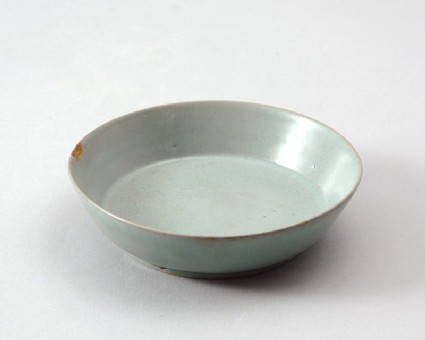Browse: 83 objects
Ru ware brush washer
- on display
- loan
-
Details
- Associated place
-
Asia › China › Henan province (Ru kilns) (place of creation)
- Date
-
late 11th century - early 12th century
Northern Song Dynasty (AD 960 - 1127)
- Material and technique
- stoneware, thrown, with bluish-green glaze; gold lacquer repair; glazed base; glazed rim
- Dimensions
-
3.4 cm (height)
12.8 cm (diameter)
- Material index
-
processed material › metal › gold,
- Technique index
- Object type index
- No. of items
- 1
- Credit line
- Lent by the Sir Alan Barlow Collection Trust.
- Accession no.
- LI1301.229
-
Further reading
University of Sussex, and Arts and Humanities Research Council, The Barlow Collection, supervised by Regina Krahl, Maurice Howard, and Aiden Leeves (Sussex: University of Sussex, 2006), no. C218
Glossary (3)
glaze, lacquer, stoneware
-
glaze
Vitreous coating applied to the surface of a ceramic to make it impermeable or for decorative effect.
-
lacquer
Chinese and Japanese lacquer is made from the sap of the lacquer tree, which is indigenous to Eastern China. It is applied to wood as a varnish or for decorative effect. In India and the Middle East, lacquer is made from the deposit of the lac insect.
-
stoneware
Ceramic material made of clay which is fired to a temperature of c.1200-1300⁰c and is often buff or grey in colour.
Location
Objects are sometimes moved to a different location. Our object location data is usually updated on a monthly basis. Contact the Jameel Study Centre if you are planning to visit the museum to see a particular object on display, or would like to arrange an appointment to see an object in our reserve collections.
Galleries
Publications online
-

The Barlow Collection
The Ru kilns at Qingliangsi in Baofeng, Henan province made the finest green-glazed stonewares for the Northern Song court (AD 960–1127), but for only some twenty years. Ru ware is therefore China’s rarest and most highly appreciated ceramic ware, and has been collected and copied for as long as it existed. Its particular qualities are its fine, even potting with thin walls, its superb jade-like, bluish-green glaze, often with a highly attractive crackle, and the firing method of supporting the pieces in the kiln on tiny spurs. This allowed the vessels to be fully glazed, thus avoiding the roughness of an unglazed foot, leaving tiny, neat ‘sesame-seed’ marks on the base instead.
The piece has low rounded sides and a thin, outward curved foot. It is fully covered with a very smooth, tactile, opaque blue-green glaze with a pleasing crackle, which in places forms an intensely blue-green glassy layer. The glaze has some pin pricks and the rim has a gilt-lacquer repair. The base shows three minute ‘sesame seed’ spur marks, radiatingly arranged, revealing a near-white clay.
© 2013 University of Oxford - Ashmolean Museum









